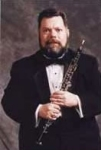
 |
Return to Tips for Oboe |
by Dr.
John W. Goodall |
Hand Position
Fingers curved. Thumbs always on the instrument, never in the air. Little fingers (pinkies) should easily reach the (left) E-flat and the (right) D-flat keys.
Posture
Sit up straight, bring the oboe to your mouth, do not "bow" or bend your head to the instrument.Embouchure
Play with an open mouth. Teeth apart, lips rolled in, mouth in a "whistle" or "pucker" formation. "Focus" towards the upper lip.
Breathing and Blowing
Breath from the stomach, but a "full tank'' is not needed. Do not "over blow" the reed; quality (a fast air stream) not quantity is the most important aspect of blowing on the oboe. Keep the air at the tip of the reed.Tonguing
Tongue with the tip of the tongue on the tip of the reed. Tongue only with the tongue; do not tongue with the jaw (chew) or tongue with the wind.Reeds
There are three requirements for a good reed:
To make reeds last longer and play more consistently: always soak reeds in water a few minutes before playing and store them in a reed case that allows them to dry out completely. Never try to play on a dry or partially soaked reed, this will cause them to crack and/or leak.
| The Texas School Music Project is a source for ideas and information concerning pedagogical practices in the music classroom or rehearsal hall. The TSMP is a service provided to all music specialists by the faculty of the School of Music at Stephen F. Austin State University. For questions about this site contact [email protected]. Copyright © 2002-2019, The
School of Music at Stephen F. Austin State University |
